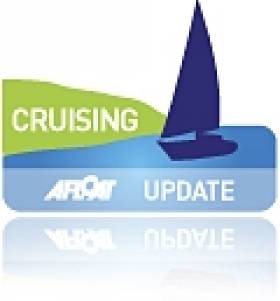Displaying items by tag: Motoryachts
#Superboats – Having spent a week visiting Dun Laoghaire Harbour, the 46m superyacht Christopher that dwarfed the local 500 plus craft and several larger craft currently taking part in the Round Ireland race departed today and follows the anchorage of 37m motoryacht Katrion to the secluded waters off Glengariff, writes Jehan Ashmore.
Such large-sized and luxuriously appointed leisure-vessels visiting Irish waters, reflects not only the high-season, but also demonstrates the appeal of our wonderful scenic cruising grounds where the role of marina's and suitable sheltered seas benefit visitor alike and the local economy.
Christopher, a dark-bull hulled ketch from the design of Ron Holland cannot be easily forgotten even when witnessed in static mode moored alongside an outer-lying berth within Dun Laoghaire Marina.
The Cayman Islands flagged vessel was berthed close to the customs cutter, RCC Suirbheir, where she and her sister, RCC Faire are relatively frequent callers to the marina.
As for the motoryacht, Katrion, the white hulled 400 tonnes vessel launched from Feadship, a leading Dutch specialist of such luxurious leisure boats yesterday anchored off Glengariff having called as reported to Cork City Marina. Likewise her sheer size made an impact along local Leeside craft.
As previously alluded the 10-guest capacity visitor also flying the flag of the these Caribbean islands was due to discover the delights of Dingle, from where Katrion departed for Glengariff.
This she did as the vessel departed Dingle yesterday and took the passage to Glengariff along the spectacular rugged Kerry and Cork coastlines. This included a call to Knightstown, Valentia Island only accessible from the northern approaches due to the low-lying bridge linking the mainland at Portmagee.
Later the motoryacht made a transit through Dursey Sound before heading for her current attractive anchorage in Bantry Bay.
Glengariff is to welcome a considerably larger leisure seeker in the form of the 190m cruiseship Amadea due next month. As previously reported, there are seven callers scheduled this season, with the Phoenix Reisen operated ship to make a repeat call.
Beforehand another caller is expected the eye-catching cruise tall-ship, Club Med 2 due in September.
Luxury 54m Motoryacht Visits Cork City Marina
#Motoryacht - Luxury motoryacht M.Y. Fortunate Sun which has luxurious accommodation for 10 guests and 12 crew docked at the Port of Cork's City Marina yesterday, writes Jehan Ashmore.
As previously reported, the 851 gross tonnes vessel on a call to Dublin Port in 2011 became the largest vessel to transit through the Samuel Beckett swing-bridge. On her visit to Cork, the vessel is moored along the pontoon off South Custom House Quay.
She is registered in the Caymen Islands and the charter vessel has a steel 54m long hull on a beam of 10.60m. The streamlined aluminium superstructure and also interiors are the work of Tim Heywood Design.
The decade old vessel completed by Oceanfast of Australia is powered by 2x 1737kW MTU 12V 4000M70 diesel engines. This delivers a flat-out speed of 17.3 knots and a range of 5,000 nautical miles.
Largest Vessel Transits Samuel Beckett Swing-Bridge
She remained alongside this berth which is normally used by large commercial ships until the vessel sought a berth much closer to the city-centre. This led to a shift of berths in the evening when the 2003 built vessel headed upriver to the Dublin City Moorings facility at Custom House Quay, but this firstly required transiting through two bridges.
With a beam of 10.6m Fortunate Sun entered through the East-Link toll-lift bridge followed by the Samuel Beckett bridge, the Liffey's newest crossing point which opened in late 2009. The €60m bridge was commissioned by Dublin City Council and designed by the Spanish architect engineer Santiago Calatrava. To read more on the bridge click HERE.
Fortunate Sun is registered in the Caymen Islands and is capable of over 17 knots on a range of 5000 nautical miles. She has a steel hull and an aluminium superstructure and interiors also by Tim Heywood Design. In the early hours of tomorrow morning the vessel built by Oceanfast is to depart through the 5,700 tonnes bridge which was delivered by barge after a five-day voyage from Rotterdam.
There has been previous transits of the bridge notably the annual Dublin Rally organised by the the Inland Waterways Association of Ireland (IWAI). This year's Dublin Rally took place on 1 May when boats travelling on the Royal Canal descended via Croke Park and entered the Liffey at Spencer Dock. This required the Iarnrod Éireann bridge-lift and the water level in Spencer Dock to be lowered so to allow safe clearance under the Sheriff St. bridge.
From there the IWAI flotilla made the short passage downriver to re-enter another inland waterway system at the Grand Canal Dock, marking where the Liffey connects with the city's southern canal. The 2011 Dublin Rally was the first time since 1955 that boats could enter Dublin from the Shannon via the Royal Canal and the first time since 2004 that boats also joined from the Royal Canal.
- powerboats
- motorboats
- inland waterways
- Dublin Port
- Dublin
- Grand Canal
- IWAI
- Royal Canal
- DDDA
- Inland Waterways Association of Ireland
- Dublin City Council
- Spencer Dock
- River Liffey
- Ports and Shipping News
- EastLink Toll Bridge
- Dublin Port news
- Grand Canal Dock
- Dublin Docklands Development Authority
- M.Y. Fortunate Sun
- Tim Heywood Design
- Lifffey
- Dublin City Moorings
- Custom House Dock
- Powerboat news
- Motoryachts
- Sir John Rogerson Quay
- Inland Waterways news
- Dublin Rally
- Ianrod Eireann
- Oceanfast
- Scottish Western Isles
































































